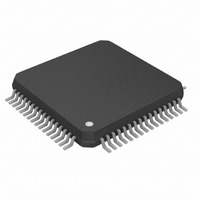DS26521L+ Maxim Integrated Products, DS26521L+ Datasheet - Page 254

DS26521L+
Manufacturer Part Number
DS26521L+
Description
IC TXRX T1/E1/J1 64-LQFP
Manufacturer
Maxim Integrated Products
Type
Line Interface Units (LIUs)r
Datasheet
1.DS26521LN.pdf
(258 pages)
Specifications of DS26521L+
Number Of Drivers/receivers
1/1
Protocol
T1/E1/J1
Voltage - Supply
3.135 V ~ 3.465 V
Mounting Type
Surface Mount
Package / Case
64-LQFP
Product
Framer
Number Of Transceivers
1
Data Rate
44.736 Mbps
Supply Voltage (max)
3.465 V
Supply Voltage (min)
3.135 V
Supply Current (max)
220 mA
Maximum Operating Temperature
+ 85 C
Minimum Operating Temperature
- 40 C
Mounting Style
SMD/SMT
Lead Free Status / RoHS Status
Lead free / RoHS Compliant
- Current page: 254 of 258
- Download datasheet (2Mb)
13.2
The instruction register contains a shift register as well as a latched parallel output and is 3 bits in length. When the
TAP controller enters the Shift-IR state, the instruction shift register will be connected between JTDI and JTDO.
While in the Shift-IR state, a rising edge on JTCLK with JTMS LOW will shift the data one stage towards the serial
output at JTDO. A rising edge on JTCLK in the Exit1-IR state or the Exit2-IR state with JTMS HIGH will move the
controller to the Update-IR state. The falling edge of that same JTCLK will latch the data in the instruction shift
register to the instruction parallel output. Instructions supported by the DS26521 and its respective operational
binary codes are shown in
Table 13-1. Instruction Codes for IEEE 1149.1 Architecture
13.2.1 SAMPLE:PRELOAD
This is a mandatory instruction for the IEEE 1149.1 specification. This instruction supports two functions. The
digital I/Os of the device can be sampled at the boundary scan register without interfering with the normal operation
of the device by using the Capture-DR state. SAMPLE:PRELOAD also allows the device to shift data into the
boundary scan register via JTDI using the Shift-DR state.
13.2.2 BYPASS
When the BYPASS instruction is latched into the parallel instruction register, JTDI connects to JTDO through the
one-bit bypass test register. This allows data to pass from JTDI to JTDO without affecting the device’s normal
operation.
13.2.3 EXTEST
This allows testing of all interconnections to the device. When the EXTEST instruction is latched in the instruction
register, the following actions occur. Once enabled via the Update-IR state, the parallel outputs of all digital output
pins will be driven. The boundary scan register will be connected between JTDI and JTDO. The Capture-DR will
sample all digital inputs into the boundary scan register.
13.2.4 CLAMP
All digital outputs of the device will output data from the boundary scan parallel output while connecting the bypass
register between JTDI and JTDO. The outputs will not change during the CLAMP instruction.
13.2.5 HIGHZ
All digital outputs of the device will be placed in a high-impedance state. The BYPASS register will be connected
between JTDI and JTDO.
13.2.6 IDCODE
When the IDCODE instruction is latched into the parallel instruction register, the identification test register is
selected. The device identification code will be loaded into the identification register on the rising edge of JTCLK
following entry into the Capture-DR state. Shift-DR can be used to shift the identification code out serially via
JTDO. During Test-Logic-Reset, the identification code is forced into the instruction register’s parallel output. The
ID code will always have a 1 in the LSB position. The next 11 bits identify the manufacturer’s JEDEC number and
number of continuation bytes followed by 16 bits for the device and 4 bits for the version.
SAMPLE:PRELOAD
INSTRUCTION
Instruction Register
BYPASS
EXTEST
IDCODE
CLAMP
HIGHZ
Table
13-1.
SELECTED REGISTER
Device Identification
Boundary Scan
Boundary Scan
Bypass
Bypass
Bypass
254 of 258
INSTRUCTION CODES
DS26521 Single T1/E1/J1 Transceiver
011
100
001
010
111
000
Related parts for DS26521L+
Image
Part Number
Description
Manufacturer
Datasheet
Request
R

Part Number:
Description:
MAX7528KCWPMaxim Integrated Products [CMOS Dual 8-Bit Buffered Multiplying DACs]
Manufacturer:
Maxim Integrated Products
Datasheet:

Part Number:
Description:
Single +5V, fully integrated, 1.25Gbps laser diode driver.
Manufacturer:
Maxim Integrated Products
Datasheet:

Part Number:
Description:
Single +5V, fully integrated, 155Mbps laser diode driver.
Manufacturer:
Maxim Integrated Products
Datasheet:

Part Number:
Description:
VRD11/VRD10, K8 Rev F 2/3/4-Phase PWM Controllers with Integrated Dual MOSFET Drivers
Manufacturer:
Maxim Integrated Products
Datasheet:

Part Number:
Description:
Highly Integrated Level 2 SMBus Battery Chargers
Manufacturer:
Maxim Integrated Products
Datasheet:

Part Number:
Description:
Current Monitor and Accumulator with Integrated Sense Resistor; ; Temperature Range: -40°C to +85°C
Manufacturer:
Maxim Integrated Products

Part Number:
Description:
TSSOP 14/A°/RS-485 Transceivers with Integrated 100O/120O Termination Resis
Manufacturer:
Maxim Integrated Products

Part Number:
Description:
TSSOP 14/A°/RS-485 Transceivers with Integrated 100O/120O Termination Resis
Manufacturer:
Maxim Integrated Products

Part Number:
Description:
QFN 16/A°/AC-DC and DC-DC Peak-Current-Mode Converters with Integrated Step
Manufacturer:
Maxim Integrated Products

Part Number:
Description:
TDFN/A/65V, 1A, 600KHZ, SYNCHRONOUS STEP-DOWN REGULATOR WITH INTEGRATED SWI
Manufacturer:
Maxim Integrated Products

Part Number:
Description:
Integrated Temperature Controller f
Manufacturer:
Maxim Integrated Products

Part Number:
Description:
SOT23-6/I°/45MHz to 650MHz, Integrated IF VCOs with Differential Output
Manufacturer:
Maxim Integrated Products

Part Number:
Description:
SOT23-6/I°/45MHz to 650MHz, Integrated IF VCOs with Differential Output
Manufacturer:
Maxim Integrated Products

Part Number:
Description:
EVALUATION KIT/2.4GHZ TO 2.5GHZ 802.11G/B RF TRANSCEIVER WITH INTEGRATED PA
Manufacturer:
Maxim Integrated Products

Part Number:
Description:
QFN/E/DUAL PCIE/SATA HIGH SPEED SWITCH WITH INTEGRATED BIAS RESISTOR
Manufacturer:
Maxim Integrated Products
Datasheet:








